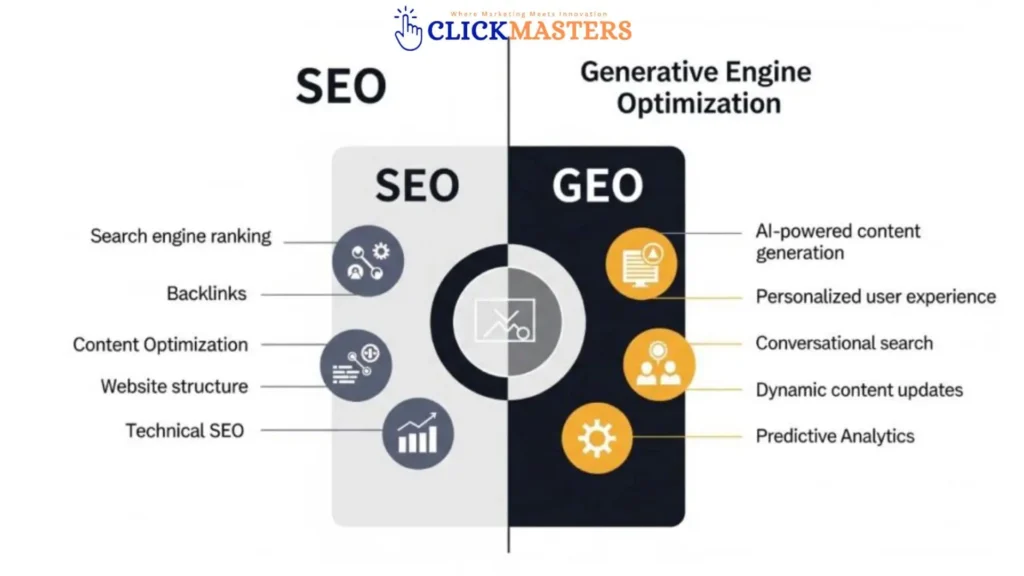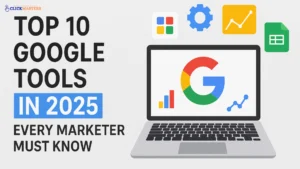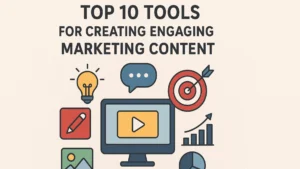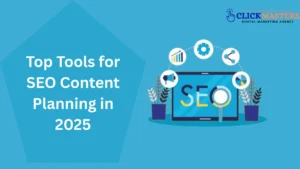What is GEO (Generative Engine Optimization) and how it help your content be picked or appear in AI tools like ChatGPT & Gemini toboost content visibility.
How GEO Works, Why It Matters & How to Rank in AI Search
Table of Contents
What is GEO (Generative Engine Optimization)?
GEO (Generative Engine Optimization) is the process of optimizing your content so it can be used, referenced, or summarized by AI-powered search engines like ChatGPT, Google Search Generative Experience (SGE), Perplexity, and Microsoft Copilot. While SEO focuses on ranking content on traditional SERPs, GEO ensures your content is selected and featured by AI bots inside generative responses. This evolving strategy is now an essential part of modern search visibility, and a professional digital marketing agency understands how to align SEO and GEO together to maximize brand exposure across both traditional and AI-driven search platforms.
GEO focuses on optimizing content for AI-generated search results, not just traditional search engines. Unlike SEO, which is designed to rank web pages on standard SERPs, GEO ensures your content is structured and written in a way that AI systems can easily understand, summarize, and reference. At the same time, related strategies such as AEO (Answer Engine Optimization) and VEO (Voice Engine Optimization) cater to different search behaviors and platforms. Understanding the difference between AEO vs GEO vs VEO is essential for modern search success, and businesses looking for reliable SEO services in Pakistan are increasingly adopting these advanced optimization techniques to stay visible across both AI-driven and traditional search experiences.
How Generative AI Search Works (Behind the Bars)
Generative AI search engines are
LLMs (large language models, systems of artificial intelligence to understand and develop human-like language processing), (GPT, Gemini )
Indexing (Indexing is the process of AI engines through which AI engines process, collect, and store data from websites) and web browsing.
Citations ( reference) and Retrieval augmented generation(RAG). RAG is an AI process that retriever; to fetch relevant documents and agenerator, through which an AI creates responses from those documents. Enabling real and up-to-date responses from a large language model.
How does it work?
| Stage | Description |
| 1. Analyze user intent | The current or pre-indexed search APIs (e.g., Bing, Google), the AI retrieves external data from relevant web sources to give exact and relevant answers. GEO uses these metrics to analyze the relevant and original content. The main motive of geo and its insight to provide its users with clear, comprehensive, and accurate data. |
| 2. Source Retrieval (RAG) | AI generates summaries, overviews, or discussions using retrieval summaries. GEO is best at user intent or a customized personal experience. Mostly target demographics, preferences, and interests create content more relevant and engaging. |
| 3. Analyze the document’s credibility | AI checks the credibility of the document first: reality, clarity, relevancy, domain authority, etc. In AI-driven searches, ensure your content is easily discoverable and prioritized by both traditional and AI-powered search engines. |
| 4. Answer creation | AI generates summaries, overviews, or discussions using retrieval summaries. GEO is best at user intent or a customized personal experience. Mostly target demographics, preferences, and interests creates content more relevant and engaging. |
| 5. Citation Linking | The AI also uses links in the info that show authoritative or representative information. |
| Elements | Search engine optimization (SEO) | Generative engine optimization (GEO) |
| Target | Optimizing search engines ( mostly Google) | It involves optimizing AI-generated answers. |
| Visibility | Shown as “blue ticks” on the SERPs. | Show as a source in the AI-generated response. |
| Ranking structure | Backlinks, keywords, and web vitals | Resource, clarity, well-structured data, and credibility |
| Discovery | Crawlers follow links | AI tools mostly choose the answers from a relevant source. |
| User conduct | The user has to click to read. | The user may not click, but answers are already generated. |
Why Traditional SEO Alone Isn’t Enough: Step-by-Step
Here are the key steps that will help to rank your content in GEO.

1. Need a Structured contextual clarity:
AI mostly prefers well-structured, simple, detailed content. The content has clear contextual clarity.
Best Practices:
Focus on using headings, mostly H1, H3, and H4. Make sure paragraphs are under 3 lines and formatted. Use numberings, bullet points, tables, and charts. Wrapping the whole content in FAQs, summaries, and final thoughts will optimize the content.
2. Respond accurately
AI mostly focuses on the “answer-first” structure.
Before: “There are many productive tools in the market…”
After: “The best productive tool in 2025 for remote workers: Trello, Notion, and Asana. Trello is ideal for visual task management…”
3. Use authentic Sources & Stats
AI mostly relies on credible, well-researched, and real-world sources. Use stats from well-known sources and add credible data to your content. Add citations. Mention the source in the text (“According to WWO…”). Your sources should be trusted and have real data, as it makes your content relevant and helps it rank in the GEO.
4. Topical Authority & Content Clustering
AI mostly uses sources that have topical and factual depth.
How to create topical and factual authority: To get topical authority, write multiple articles revolving around the same topic. Use hub & spoke models (e.g., “GEO for eCommerce” linking to subtopics).Answer related questions in the same post. It will help your content to get trust from AI and also a factual authority because you are targeting questions related to the post.
5. Include an In-Depth FAQ Section:
AI likes and targets the frequently asked questions because they are easy to phrase, summarize, and collect data on the topic. Include 5-10 FAQs in an article. Use real queries and questions from forums (Reddit, Quora, People Also Ask). Make sure your answer will be short, below 100 words, and it has solutions to the problem of people, but in a summarized way. Because AI usually targets these summarized and short forms of any content.
6. Use Schema markup (Advanced)
Add article schema markup (blueprint that defines how data is organized, stored, and how related to data), add FAQs schema, and How To markup. Helps in the generative search experience GSE, so AI can better give you engaging content. Improves chances of appearing in featured snippets or citations.
7. Establish Author Expertise
Generative AI engines mostly rank authoritative data higher. Add the author’s bio and also add credentials, which should be linked to your LinkedIn and guest posts. Adding their expertise will help your content to optimize in GEO.
Data & Trends: Why GEO Is the Future
Here are some statistics that show that GEO is the future.
| Statics | Insight | Source |
| 65% of Generation Z users are most likely to prefer AI overviews and summaries over traditional search engine clicking. | Young users mostly like to use ChatGPT over Google usually avoid search engine result pages. | Statista, 2025 |
| Long articles more than 1500 words, are 3x more likely to be referenced in generative search data. | AI answers and summaries are now fulfilling the user’s intent. | Ahrefs, 2024 |
| 30–45% drop in traffic after the launch of the search generative engine. | A lot of content on web browsers doesn’t have well-structured data and details. | Backlinko AI Content Study, 2024 |
| A massive numbers of people gets their answers from generative engines. | Structured data is mostly preferred by GEO. Only engaging, detailed, and authentic data is optimized by GEO. | ClearScope, 2025 |
| 60% digital marketers now prefer geo-focused strategies over traditional SEO. | Now, most technical industries are geo-focused | Content Marketing Institute Survey, March 2025 |
| Google’s SGE now appears on 87% of mobile searches in the U.S. | The search generative engine is now dominated. | Search Engine Land, Q2 2025 |
| 38% of global search traffic now flows through AI-generated answers | a massive numbers of people gets their answers from generative engines. | Global Web Index, 2025 |
Advanced GEO Tactics for 2025
Use Language Models Yourself
Paste your article in any generative engine like ChatGPT or perpexility.AI and command “Which parts would be referenced in an AI answer to this query?” Revise the part that the bot ignores or misinterprets.
Create “AI-Friendly” Summaries
Write 2–3 sentence summaries at the beginning of the content. This will help LLMs cite key insights fast.
Update Old Content
Update old content with fresh stats, dates, and a clearer data structure. Make sure the factuality still matches current trends.
Final Thoughts: The Future of Search Is Generative Engine Optimization
It’s 2025, and users are diverting towards AI from search engine result pages. To stay in this tough competition, your business has to adapt to these GEO strategies.
Write well-structured, authoritative, and detailed content.
Optimize content not just for generative engines, but for AI comprehension.
Think like AI, “Would it be referenced in summaries?”
Want some professional help for optimizing your content in generative Engine optimization? Contact us!
How can Click master digital marketing Agency help to boost your content visibility with AI tools?
Clickmasters will help your content in ranking for generative search engines like ChatGPT, Gemini, or perplexity:
- Adding relevant keywords
- Structuring content with FAQs, headings, and schema
- Refining and testing your content for the best performance in GEO.
- Creating relevant, AI-friendly, and authoritative content for the best ranking.
Common Questions (FAQs) on GEO for SEO Professionals
So, GEO is just for the AI tools such as ChatGPT?
No, GEO supports AI-based content summarization and optimization for any platform, such as:
Google SGE
Microsoft Copilot
Brave AI
Meta AI
Perplexity
How to tell if you were quoted by AI?
Ways to find out:
A: Use Perplexity, look in “Sources” beneath the answer.
ChatGPT + Browse Mode, Paste your blog URL, and ask what it says.
Is keyword optimization still a thing in SEO?
Yes, but semantic relevance is greater than keyword density.
You can use: Synonyms, Variants, Related topics, and Question-based phrases
Do backlinks still work in GEO?
Yes, but their mission is changing.
Why they still matter:
Backlinks increase domain authority, which the AI takes into consideration as a trust signal. More backlinks = more probable your site exists on the top returned results prior to AI coming up with its answer.
What types of content are close to AI?
5. What types of content are close to AI?
Rankings, FAQs, Guides (how to), definitions ( What is…), these types of templates are easy for AI to cite.
Will AI replace SEO completely shortly?
No, it’s just evolving. Traditional SEO is about rankings on the Search engine result pages
GEO is the visibility of your content in the AI response. The future of search is hybrid: Human + AI + SEO. You’ll need both to survive the content game in 2025 and beyond.








